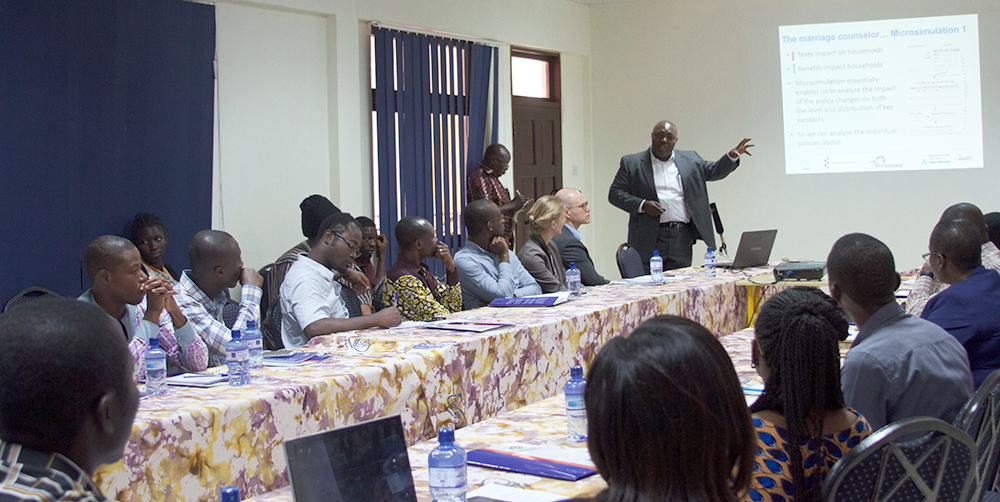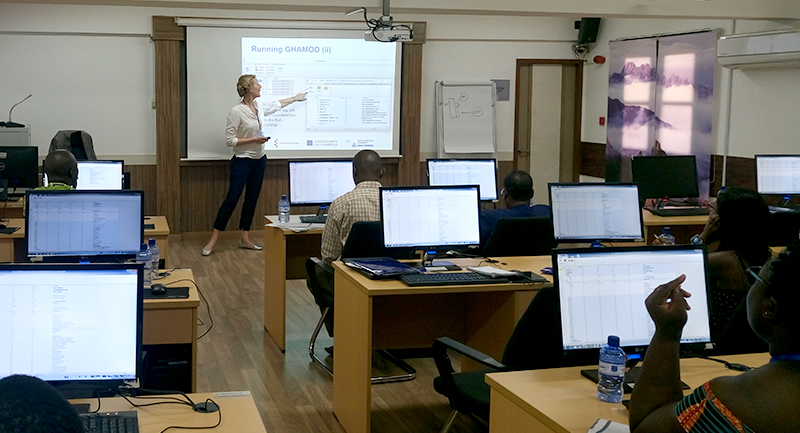Blog
GHAMOD launch and training
A tax-benefit microsimulation model for Ghana
Better social protection coverage and greater benefits in developing countries would certainly be welcomed by many. More and better forms of social protection would reduce extreme poverty, build resilience against shocks and even help households to move out of poverty, by making it possible for countries to invest in education, health, and productive activities.
The trouble is, as ever so often, the financing side. Developing countries already struggle to raise sufficient revenues. Additional expenses could easily lead to widening government deficits. Revenue-neutral reforms, thus policy reforms that finance new or additional benefits by raising taxes, may have ambiguous effects on poverty. Knowing what different policy options mean for the country helps decision makers make sound choices.
Tax-benefit microsimulation
Tax-benefit microsimulation is a very handy tool to shed light on social protection and taxation policy choices. These models, which combine representative data on household incomes and expenditures and detailed coding of countries’ tax and benefit legislation, are routinely used in the analysis of policy reforms in many, mostly developed, countries. They provide answers to questions — such as who benefits from tax and benefit reforms, how much such reforms cost the government, and what are the impacts on poverty and inequality.
Developing countries have largely lacked these models; yet having access to such models would be useful and topical, given the increasing need to raise revenues and expand social policies in the developing world. These are some of the reasons why UNU-WIDER has launched the SOUTHMOD project, developing tax-benefit microsimulation models for a number of countries in Africa and elsewhere.
Tax-benefit microsimulation is also an excellent tool for bringing ‘discipline’ to the policy discourse by providing solid evidence. Microsimulation is, in this way, fundamental for policy deliberations and discussions: proposed policy reforms must be concrete enough so that their effects can be simulated, and the benefits and costs become transparent.
The launch of GHAMOD
In May we launched GHAMOD, a tax/benefit microsimulation model for Ghana, which was developed as a joint undertaking between UNU-WIDER, ISSER of the University of Ghana in Legon, and the University of Tampere in Finland.
Like other models within the SOUTHMOD initiative, GHAMOD is based on the EUROMOD platform. EUROMOD is, in addition to offering a microsimulation model for European countries, also a tailor-made software for building new tax/benefit microsimulation models. It offers to users easy, yet fully flexible possibilities for modelling new tax and benefit policies. A key benefit of EUROMOD, and its future application in SOUTHMOD, is comparability across countries, since countries’ underlying data sets have been modified, and polices coded, using the same modelling guidelines.

GHAMOD is based on the 6th wave of the Ghana Living Standards Survey (GLSS6) for 2012/13 and includes policy rules for 2013-16. It simulates the LEAP cash transfer benefits, schooling benefits, and most taxes (labour income tax, social security contributions, capital income taxes, presumptive taxes for small businesses as well as value-added tax and excises).
The model’s main purpose is to examine how changes in existing policies affect the income distribution and government revenues and expenses. Exploring the impacts of completely new benefits is particularly interesting. For example, GHAMOD has been used to study the impacts of introducing an old-age pension system, with those without any existing pension rights as recipients and benefit amounts equal to the amounts of the existing social assistance programme, the LEAP.
The basic tax-benefit microsimulation results capture ‘morning after’ effects, where households or firms have not yet been able to respond to policies by changing their behaviour, such as by working or producing more or less. However, behavioural responses can be incorporated into microsimulation, and such work is also underway at UNU-WIDER.

Training and discussion bring insights
The launch of GHAMOD was followed by a training course. Approximately twenty-five participants — including representatives from the Ministry of Finance, Ghana Statistical Service, the German Corporation for International Cooperation (GIZ), the National Development Planning Commission, the Ashesi University, and the University of Ghana — learnt about GHAMOD, EUROMOD software, and how to interpret results. An integral part of the training was a set of hands-on exercises that varied in the degree of difficulty from simply running the model to examining the impacts of introducing a completely new child-benefit policy for Ghana.
As trainers and model developers, we hope that the training was useful and stimulating for the participants and will prove useful in their work. It certainly gave us a lot of food for thought on how to improve the model, in the immediate future but also in the longer term. The model that will be distributed for users (free of charge, for non-commercial purposes only), will also include policy rules for the latest year, 2017. Participants saw a need for simulations of certain public services, such as education and health services, and some subsidies, e.g. those on fertilizers, in future versions of the model. They were also curious how potential modelling errors can be spotted and corrected.
The response to the latter question will largely rest on how many users will employ the model. An active users’ group makes modelling easier for the modellers through peer group support and it certainly helps in spotting mistakes and areas for improvement in coding thanks to constant user feedback. The GHAMOD team at UNU-WIDER and ISSER very much welcomes the use of the model, stands ready to offer support to users and provide updates of GHAMOD, and hopes for a wide dissemination of the model.
The views expressed in this piece are those of the author(s), and do not necessarily reflect the views of the Institute or the United Nations University, nor the programme/project donors.
 Join the network
Join the network



